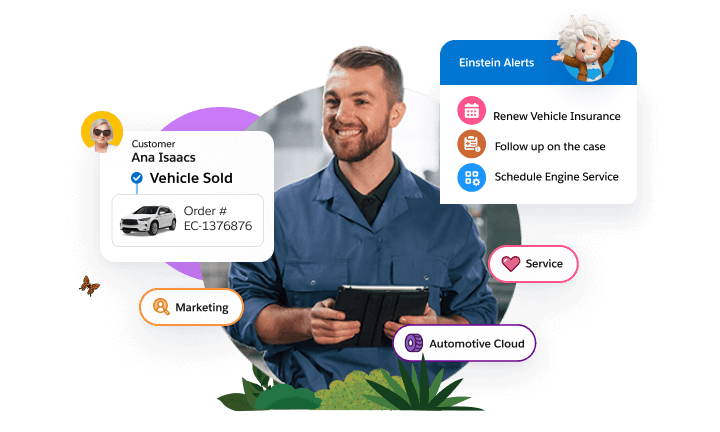Merging Driver and Vehicle Data for a New Automotive Experience
Data from the connected ecosystem can help achieve higher revenue and reduced time to market.
Unlike other automotive industry challenges like autonomous driving and EVs, connected vehicles will help OEMs build their business by reimagining and monetizing personalized, in-vehicle experiences.
Imagine you’re on a family ski trip, driving to the mountains. Your customized journey includes your preferred ambiance and the GPS is set. A 70's Road Trip playlist streams through the speakers with "Heroes" by David Bowie. Anticipating colder weather, you’ve already activated the heating package subscription via an over-the-air update. On the road, snow starts falling and sticking to the ground, which triggers automated prompts to optimize steering settings and sensors for slippery roads. Lane lines disappear in the whiteout, so lane-keeping assist turns off to prevent unwanted alerts.
Now imagine offering your customers this experience. Normally, they’d have kids arguing in the back while you’re changing radio stations and heat settings, and briefly losing traction on an icy patch on the road. Think they’d prefer this streamlined experience rather than manually operating each setting?
Using real-time data, you can offer additional feature, trial, or upgrade offers based on intelligent recommendations. These interactions can make driving safer, greener, and more fun. All because both customer and vehicle data are creating a new customer experience.
Connecting data from the vehicle, app, and driver – including telematics, the digital chassis, etc. – creates a connected ecosystem that helps you create these personalized experiences for your customers. Vehicles are fast becoming more like smartphones on wheels. What does that mean for you? Optimized recurring revenue through faster time to value and better decisions fueled by more complete customer and vehicle behavior data.
The first-party data collected from connected vehicles and drivers will be instrumental in building a new and better customer experience. Connected cars will make up about 95% of all new vehicles sold globally by the end of this decade. They will create an estimated 100 petabytes of data per month that you can tap to improve customer experiences and generate revenue faster than ever. That sounds like a lot of data, but here is what it can do for you.
How can data help to create a new vehicle experience for customers?
Learn how to streamline automotive experiences and reduce costs with Automotive Cloud.
of automotive companies agree that first-party data will substantially improve the customer experience.
A majority of automotive companies (93%) agree that first-party data (taken in part from connected vehicles) will substantially improve the customer experience. But to make the most out of the connected ecosystem you’ll need help transforming data into actionable insights. Automotive Cloud is a purpose-built platform that can automate processes and enable collaboration across your business – from customer support to engineering to marketing and e-commerce. As one company put it, Automotive Cloud isn’t so much a tool as a foundation for a new business model.
Here is what unifying driver and vehicle data can do for your business.
Bring updates and new products to market faster.
The connected ecosystem adds value via higher revenue and more growth opportunities. Insurance-as-a-Service is one example: offers and rates can change based on how cars are driven. OEMs benefit from sharing the data with insurance companies, or can even bring insurance-as-a-service in-house. Today, a black box can capture this information for later analysis, but future applications that take data directly from the vehicle in real time will provide more insight and better advice and incentives for the driver. For safe drivers, this can provide real value and increase brand engagement. And less safe drivers, such as younger drivers, could see incentives for safer driving habits.
Advanced driver assistance systems (ADAS) are another set of increasingly-monetized features for connected vehicles. Drivers aren’t likely to remember every available ADAS or may turn off features and forget about them. An OEM could use customer data to track which ADAS features are unused and prompt customers that are likely to use them. (Customers would need to opt-in to such offers, in addition to the monitoring and purchasing.) Reminders at moments in which specific features might be useful can spur usage and increase revenue opportunities.
Vehicles are becoming “digital devices on wheels.” How should OEMs and dealers use the different data points they have?
The connected ecosystem can provide valuable information for research and development (R&D). Manufacturers can combine pre-sales vehicle testing data with real-world car usage data to better inform engineers on various metrics. This feedback loop could lead to a higher quality product. By using data to make informed decisions and automate processes, you can reduce time to market and create a better vehicle.
Aside from monetary gains, real-time data can help people improve their driving – including automating tips to reduce tire wear or their carbon emissions. Other ancillary features could provide value like a car concierge reminding you to pack your kid’s sport bag for a Saturday morning game.
Personalize the experience for both drivers and passengers.
Typical onboarding for a new car purchase only covers a fraction of the features available in the vehicle. Customers are expected to read about the rest in the manual. Only 29% do. But, with connected vehicles, new purchasers will be able to learn, select, and even configure features prior to handover - all through a connected app. Imagine if your customers could select options for seats, sound, infotainment, etc., before their first drive. This is a key time for OEMs to showcase features, offer trials, and gain subscriptions.
Onboarding could be a 30-60-90 day journey with targeted communications, based on the customer’s preferences. With a connected car app (through the OEM or leasing company), you can prompt customers with messages about how to get the most out of their car. When onboarding is seamless and straightforward for customers and they learn to use new features, it can cultivate brand engagement in a big way.
“Software will define the future of the automotive industry from purchasing to driving to maintenance. Having driver and vehicle data in one place makes it possible to have a truly personalized experience that will wow customers.”
By understanding their preferences and driving habits, you can zero in on specific features they would want to activate. An ADAS feature in particular lends itself to just-in-time education and the ability to offer a service in relevant moments. Imagine if your vehicle was smart enough to realize you were about to park and offered you an ADAS feature with a seamless walkthrough. The customer would notice and appreciate the convenience of that experience.
Software upgrades, especially relating to range, can increase the car’s lifetime value. Customers are more likely to remain with a brand if they believe the asset won’t depreciate as much as others. In the future, vehicles will be able to offer the right feature at the right time, such as adaptive cruise control on a long highway journey or enhanced lighting when driving at night. And when OEMs charge for these features, it also increases revenue.

Accelerate recurring revenue and increase share of driveway.
OEMs will (some already do) see the digital version, or digital twin, of each vehicle sold, which software version it is running, and what features are available. With this you can prompt customers to activate features via automated workflows, and monitor how they are used. Once that is established, OEMs can encourage renewal of those features and gather product feedback that can be used to improve future models and software updates. All of these interactions are supported by a digital chassis, or digital framework/platform, of everything electronically controlled in the vehicle.
Data about which features customers are using are usually stored in a phone app, which allows flexibility for customers to take their preferences from one vehicle to another (of the same brand) or to share them with someone in their household who also drives the car. Do you know who else shares the driveway with your customer?
In the future, parents could activate a vehicle safety pack for a teenager who recently started driving. Knowing these details helps you capture data that can make your messages more relevant to the customers’ lives and needs. This allows for more personalization, which can increase brand engagement and the opportunity for recurring revenue.
What does Automotive Cloud specifically address for businesses?
Scale effectively by mastering the fundamentals.
Some of the biggest hurdles to this connected future also lead to best practices for business. You’ll need smooth, efficient operations to realize the full benefits of a connected ecosystem and create great customer experiences. Here are some of the main fundamentals that will be essential for the digital future:
- Unifying data is the first step. Automotive Cloud combines Customer 360, Driver 360, Vehicle 360, and Financial 360, by aggregating and augmenting data from third-party systems of record.
- Merge the customer experience with the physical vehicle. The next evolution is to connect the digital chassis with real-time CRM. With data all in one place, connecting front-end commerce and back-end engineering can lead to insights about what offers will appeal to different customers and whether the features are valued. The right offers at the right time create a customer experience that leads to brand engagement and more revenue.
- Seamless software updates are key. Customers will demand that over-the-air (OTA) updates are fast and convenient. Making the most of these capabilities requires quality assurance, test management, and quick internal decision-making. This will be one of the main ways your customer experiences your brand and how the car can offer new features, so perfecting it is key.
- Scale internationally with a consistent platform. Using the same processes for subscriptions, for example, across every country you do business in will save on costs and increase revenue by making it easier to implement in more places. Some countries will have different regulations and needs, but with an adaptable system and set processes, there is no need to reinvent the wheel each time.
Consistent operations lead to a consistently great customer experience. Build trust with customers by having set processes for subscriptions and upgrades, and easy access to answers they need.

A game-changer for drivers.
The automotive industry has a new strength – the ability to see and act on what is happening with the digital chassis in real time. The possibilities for improving customer experience are more exciting than ever. Unifying your data is step one. Connected car applications, marketing automation, and e-commerce all need to be linked to provide the best experience and make a lasting impact on your customer. Tracking subscriptions, usage, and deploying the right communications at the right time – and at scale – is easier when you have the tools you need. Automotive Cloud is a unique solution that can do all this, as well as manage complex opt-in permissions. Activating and understanding new features – safely, while driving – is a game-changing experience for customers.
The real-time, connected ecosystem of cars and drivers is a foundation that will revolutionize the automotive industry and increase revenue for OEMs. Roll down the windows and turn up the stereo – we’re driving to a new frontier.

When Selling Cars, Know Your Customers or Lose Them

Trends in Automotive

Unlock Efficiencies for a More Engaging Automotive Customer Experience
More Resources

Salesforce for Automotive Demo

How Auto Dealers Can Fast Track Efficient Growth Through Customer Data




